|
Go
to:
CROSSOVER
CABINET
MEASUREMENTS
KIT
RESPONSE-BUILDERS
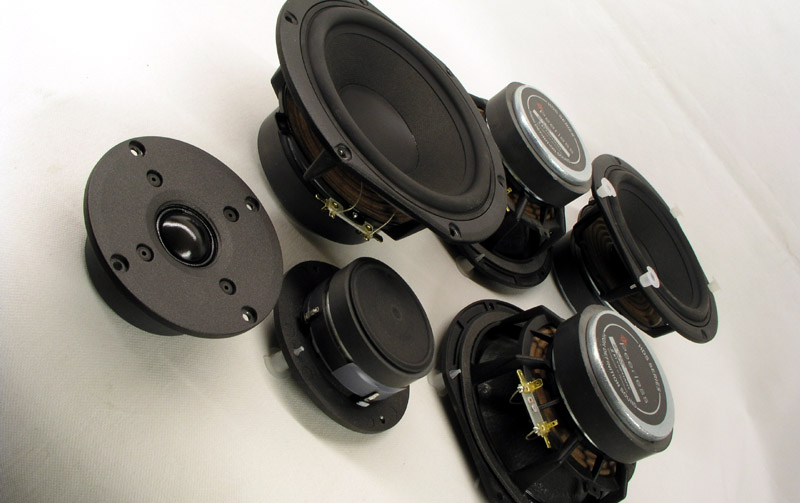
Peerless HDS164 Nomex
830875 + ScanSpeak Discovery
tweeter
D2608/9130
Click
links to download driver specs.
I've
had these drivers on the shelf for more
than two years and since the Peerless 850438
drivers were discontinued, I've had regular
requests on a new 2½-way from Peerless drivers,
thus this "NOMEX 164" with the Peerless
drivers shown below. The main reason for my
evasiveness was a feeling of what these drivers
could offer I hadn't heard many times before, but
as a hifi dealer advertises: Don't be afraid to
be surprised!
I
think these drivers deliver an excellent
cost performance ratio and I was really surprised
when I made the final set-up in our living room
driven by my JungSon class A amp. I usually make
my test crossovers from Superior Z-caps, good
baked coils and 10 watt MOX resistors and all in
all these drivers makes me wonder why I ever
spend money on "high-end" drivers.
These NOMEX drivers have an excellent midrange
presentation and if you're seeking a driver that
will handle vocals and piano notes with grace,
try out these drivers. I was pleasantly
surprised.
The 830875 is a bit peaky in the 4-6 kHz range,
but nothing that can't be fixed in the crossover,
and nothing that seems to distress the ear. The
Peerless HDS 810921 (now ScanSpeak D2608/9130)
tweeter is a very well engineered unit,
impeccable finish and assembly - all reflected in
price, which is not down to XT25 level, but worth
every penny. I won't make an XT version as this
D2608/9130 does so well, so please do not ask.
I've
picked some really good coils for the
crossover and added Superior Z-caps because these
drivers deserve it. Should you want to save
approx. 60 EUR, use standard polyprops. The
drivers alone will be some 300 EUR from the
cheapest supplier I can find (Dutch supplier). I
won't recommend this supplier as they don't
respond to emails and generally pack poorly, so
don't ask who it is.
QUESTIONS
having the answer NO:
Can I use another tweeter? Can I change the front
panel layout and driver placement? Do you have
more detailed drawings? This should eliminate the
bulk of mails.
Can I use it up-right? Depends. I tried
everything from up-right to a 5 deg tilt and
ended up with some 3-4 deg tilt allowing
listening at tweeter level. This made the best
vocal performance to me. I suggest a tilted base
plate as shown with adjustable rear feet/spikes.
I
assume these HDS drivers on the German
market are: Peerless HDS N-6-33/08 (midbass) and
Peerless HDS DT 26/08 (tweeter). I can't figure
out why the German market always re-label
standard drivers. This kind of market protection
is long gone with current internet sales. At
Strassacker you can find both drivers holding
exactly the same data.
The Crossover
BACK TO TOP

R1061 is optional.
Leave it out and you get plus ~1-1.5 dB treble level. See
graphs below.
Crossover
Kit
BACK
TO TOP
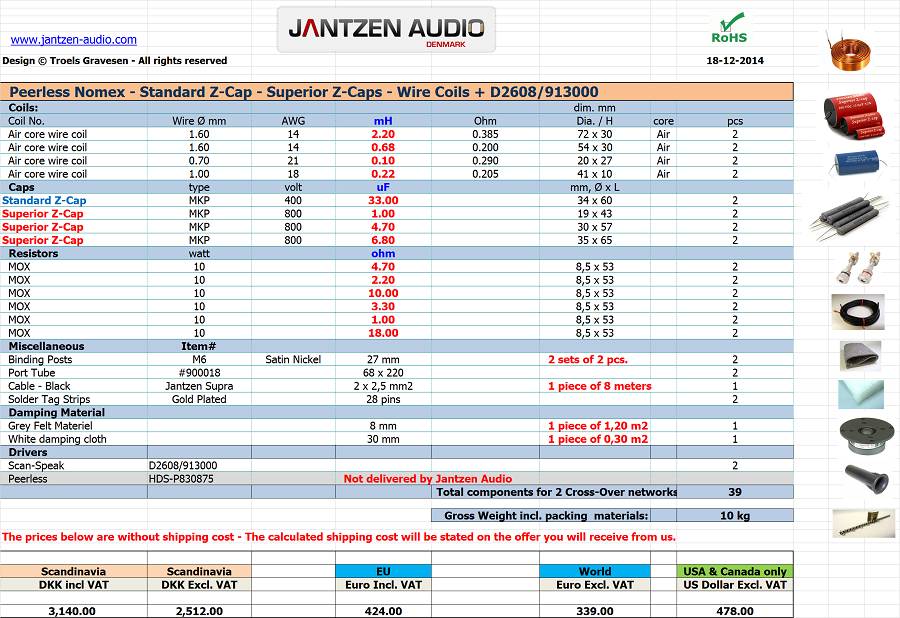
Complete crossover
kit excl. drivers is available from Jantzen Audio:
contact@jantzen-audio.com
All kit and component prices may
be subject to change and are always to be confirmed by Jantzen Audio
Denmark.
Download complete kit options
here
(pdf file)
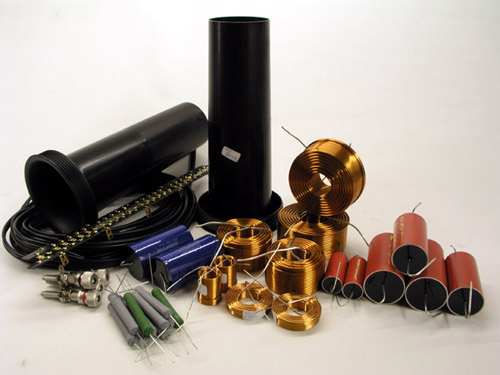 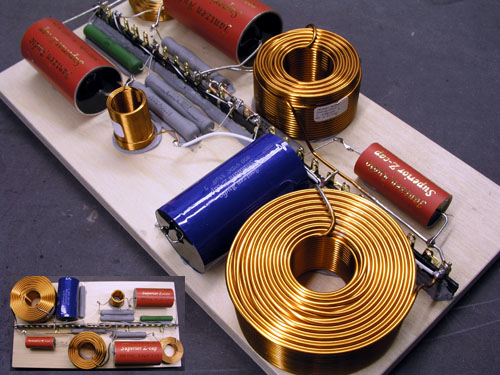
Crossover kit incl.
ports, terminals, solder tag strips, wire, caps and
coils.
Cut ports to 80 mm length for Fb = 45 Hz and 34 liter cab
volume.
Crossover Layout
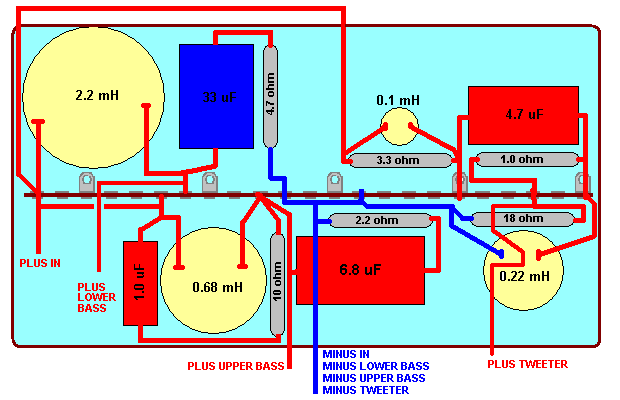
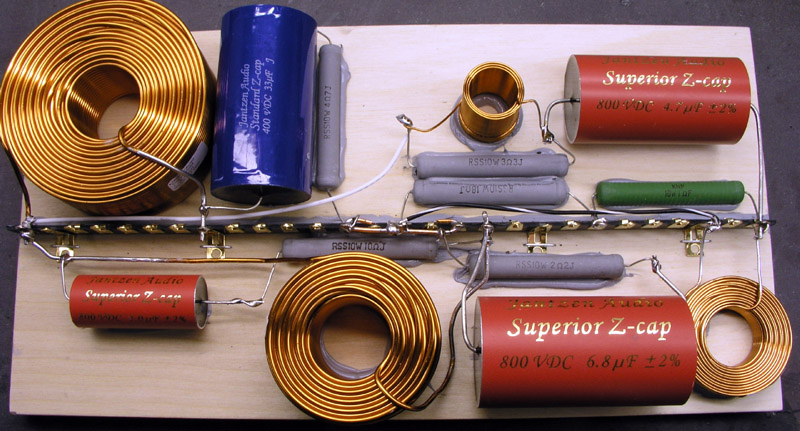
Final crossover. A
little different from the drawing.
You need to add two wires on the board. One from + IN to
R1011/L1011 (white) and one from L1041 to ground
(black/white).
The
board shown here is 140 x 270 mm, 12 mm baltic birch.
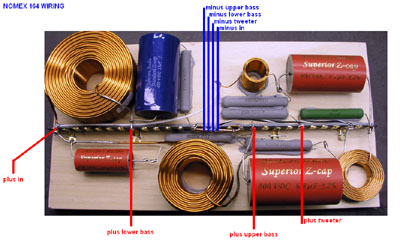
Click image to vie large.
The Cabinet
BACK
TO TOP
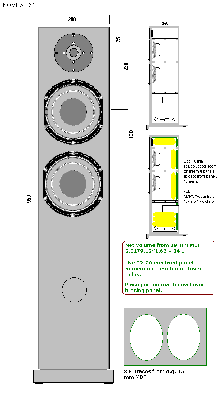
Click image to view
large.
Check this file for cabinet damping suggestions.
Port tuning
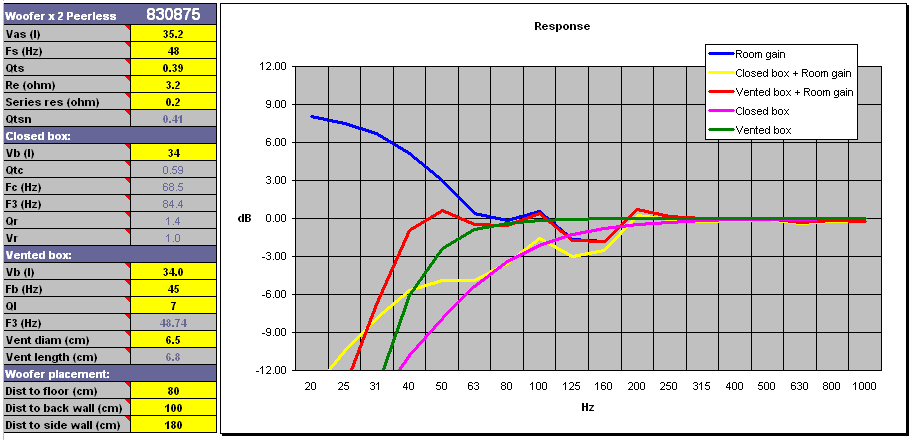
Box simulation for
two drivers. I suggest port tuning of 45 Hz providing F3
= 45 Hz.
Ports for Fb = 45 Hz:
60 mm diameter: 55 mm length.
65 mm diameter: 68 mm length.
68 mm diameter: 80 mm length (Jantzen port)
70 mm diameter: 82 mm length.
You may
increase cabinet size to 40 liters without problem and
get another 3.5 Hz bottom end extension.
Maintain port tuning Fb = 45 Hz and cut 68 mm (D) port to
60 mm length.
Increase cabinet depth and maintain height and width.
The
830875 drivers have a fairly high Fs and take
some heavy beating to break in. And don't be
afraid to do so, the 33 mm voice coil takes a lot
of heat and my JungSon drove the speakers to 95
dB @ 2½ meter without noticeable distortion.
Well done! They deliver a punchy bass that even
can be felt. Do not expect anything in the 20-40
Hz range. If you look for earthquake experiences,
add a decent 10-12" sub. I actually think
these speakers are excellent for this application
and you may try adding a small amount of foam to
the vent to make an aperiodic tuning to fine-tune
sub-sat integration.
|
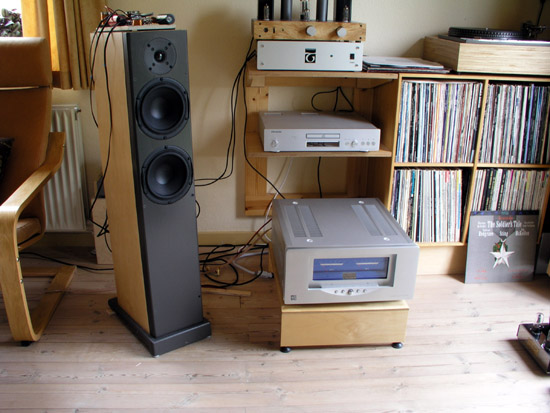 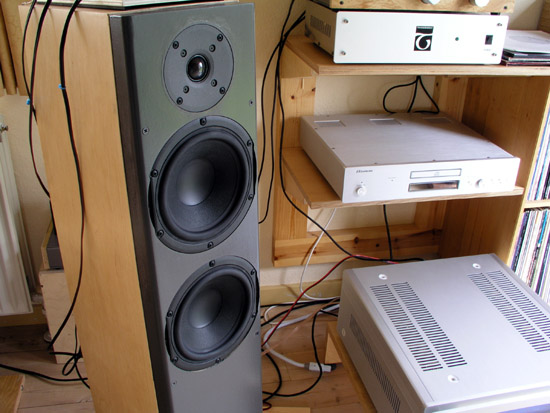
These test cabs has
seen a lot of drivers. Last time the CNO25 and I could modify the CNO25
front panels to accommodate the Peerless drivers.
I really hate truncated drivers as they make routing very
critical.
I would make the front panel from a 165 mm center panel
(minimum diameter of Nomex driver) and add fillets to
make 200 mm total width.
In fact, you really don't have to flush-mount the Nomex
drivers, if you can live with this. The tweeter must be
flush-mounted as seen above.
Measurements
BACK
TO TOP
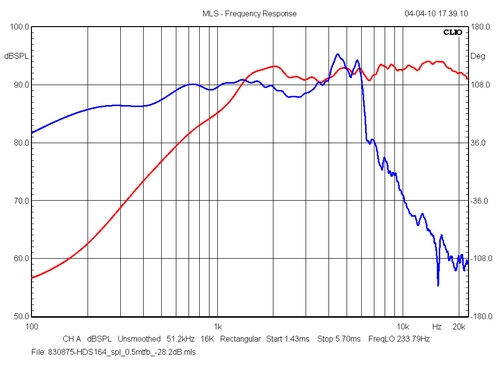 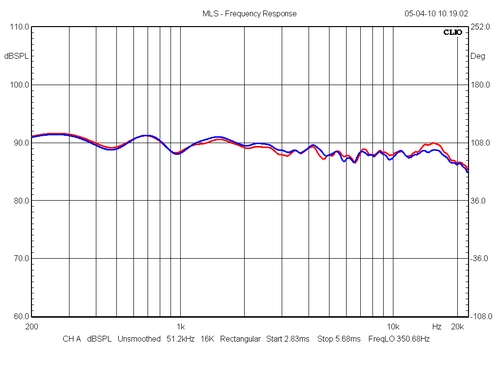
Left: Driver response from shown cabinet
driven without crossover. The midbass a little peaky at
4-6 kHz but generally a smooth roll-off profile.
Right: SPL/2.8V @ 1 meter for the two speakers. Quite a
matched pair! Overall system sensitivity = 90-91 dB.
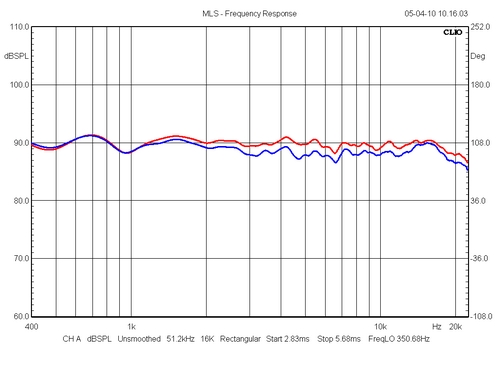 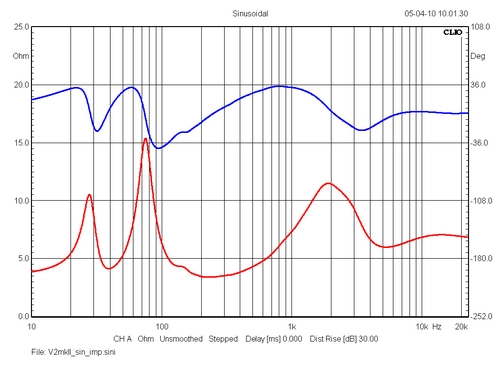
Left: SPL from various tweeter
attenuation. Blue with R1051 in place. Red = R1061 left
out. Take your pick!
Right: Final system impedance. Minimum = 3.5 ohms at
200-300 Hz.
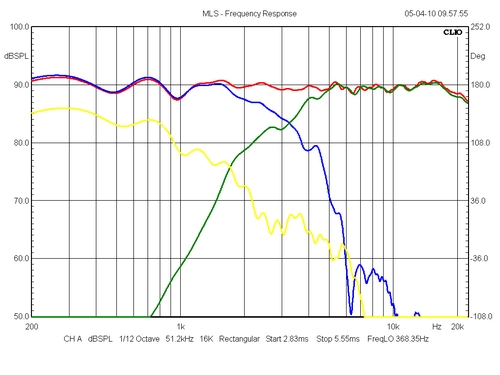 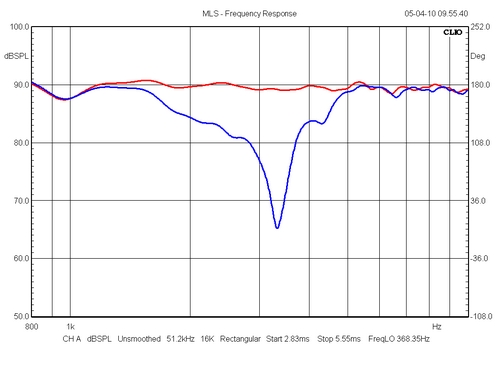
Left: SPL from drivers driven from
crossover. Yellow = lower bass unit.
Right: Blue = SPL from inverted tweeter polarity. Point
of crossover ~3300 Hz.
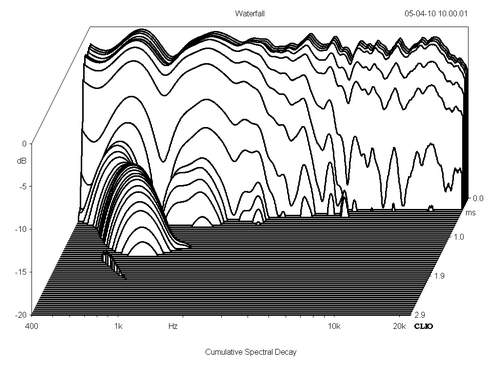 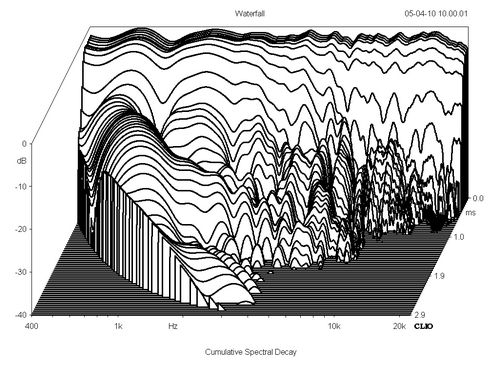
Left: CSD/20 dB scaling. Right: CSD/40 dB
scaling.
Nomex 164
builders
BACK
TO TOP
|


















